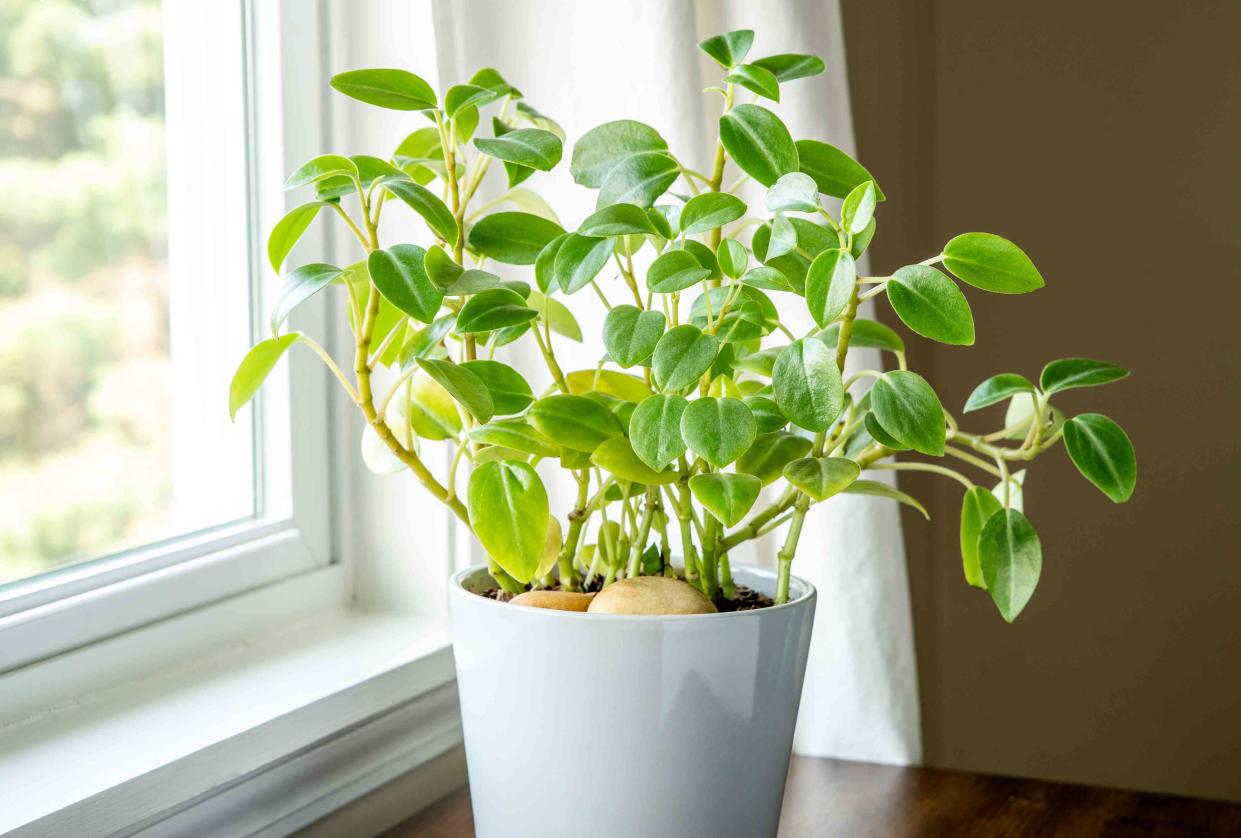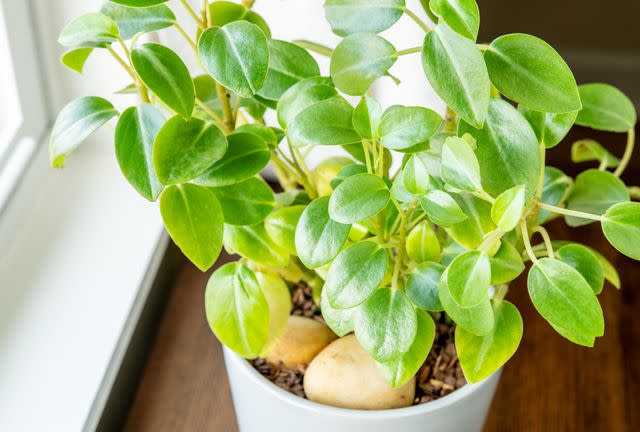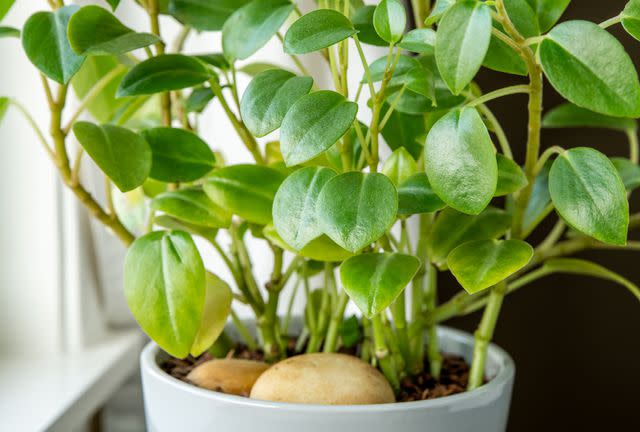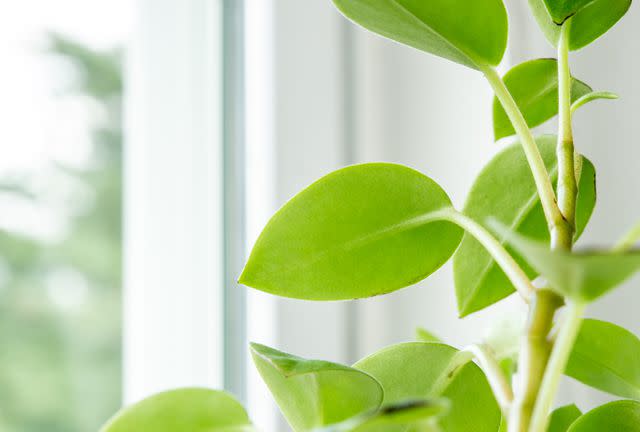How to Grow and Care for Peperomia Orba (Peperomia Pixie Lime)

The Spruce / Adrienne Legault
Peperomia orba, also commonly known as peperomia pixie lime, is a perennial commonly grown as a houseplant. Peperomia orba is a semi-succulent, so it grows best in light, well-draining soil and prefers full sunlight and warm temperatures.
Common Name | Peperomia orba, Peperomia pixie lime, peperomia teardrop |
Botanical Name | Peperomia orba |
Family | Piperaceae |
Plant Type | Perennial, succulent |
Mature Size | 4-6 in. tall, 4-6 in. wide |
Sun Exposure | Full, partial |
Soil Type | Well-drained |
Soil pH | Neutral to acidic |
Hardiness Zones | 10-12 (USDA) |
Native Area | South America, Central America |
Peperomia Orba Care
Like other types of peperomia, you can have success growing this plant as a houseplant if you follow a few basic guidelines. Here’s what you need to know about the basic care requirements for peperomia orba.
Plant in a loose, well-draining soil mix.
Choose a location that receives bright, indirect light.
Water deeply but infrequently; the soil should dry out between waterings.
Fertilize monthly during the growing season.

The Spruce / Adrienne Legault

The Spruce / Adrienne Legault

The Spruce / Adrienne Legault
Light
Peperomia orba does best with full to partial sun. Too much direct sun can scorch the plant, so a location that receives bright but indirect sunlight is ideal. Usually, this can be found near a north- or east-facing window. If you place it near a south- or west-facing window, keep the plant back a few feet to avoid over-exposure.
Soil
This plant prefers a soil mixture that is light and loose, which allows for fast, efficient drainage. If the soil becomes soggy or retains water, the plant can suffer from root rot. An orchid potting mix is a good choice or you can also use potting soil or coco coir combined with perlite or sand in a 2:1 ratio for a lighter, looser consistency.
Water
As a semi-succulent, peperomia orba benefits from deep, infrequent watering. Saturate the soil and then allow the top several inches of the soil to dry out completely before watering again. When the plant goes dormant during the winter months, withhold water for longer periods of time. You may only need to water every few weeks during periods of cool weather.
Temperature and Humidity
Well-suited for life as a houseplant, peperomia orba prefers temperatures between 65 and 75 degrees. These plants aren’t picky regarding humidity; they’ll do fine with average indoor humidity levels between 40 and 60 percent.
Fertilizer
Peperomia orba isn’t a heavy feeder, but you might choose to fertilize the plant monthly during its active growing season. If you do, use a balanced fertilizer formula, like 10-10-10. Apply it according to the label instructions. Be sure to avoid fertilization during the plant’s dormancy period.
Propagating Peperomia Orba
Peperomia plants are easy to propagate at just about any time of the year, but the most ideal time is during the spring and summer growing seasons. Stem cuttings are a tried-and-true method of propagation but these plants can also be propagated through leaf cuttings. Here are the steps to follow:
Stem Cuttings
Gather the following supplies: sterile pruning snips or scissors, rooting hormone (optional), a small pot, soilless potting mix, or orchid mix.
Identify a stem with a few healthy leaves. Snip at least an inch-long section from the plant.
If desired, dip the cut end of the stem in the rooting hormone. However, peperomia orba generally doesn’t require rooting hormone to successfully propagate.
Fill the pot with the soilless mix or orchid mix and plant the cut end of the stem in the soil.
Keep the soil moist but don’t cover the pot with plastic, since the environment could become too humid and saturated for successful growth. Keep it in bright, indirect light.
After 4 to 6 weeks, roots should begin to form. Grasp the plant and lightly tug it to check for resistance from root growth.
Transplant cuttings to a larger pot as needed, keeping in mind that these plants prefer a snug pot.
Leaf Cuttings
Gather the following supplies: sterile pruning snips or scissors, rooting hormone (optional), a small pot, soilless potting mix, or orchid mix.
Snip a healthy leaf and its petiole (the stalk that joins the leaf to the stem), making the cut as close to the stem as possible.
Fill the pot with the soilless mix or orchid mix and plant the leaf in the soil, leaving about 80 percent of the leaf exposed above the planting medium.
Keep the soil moist but don’t cover the pot with plastic to avoid excessive moisture and humidity levels. Keep the pot in bright, indirect light.
Leaf cuttings may take slightly longer to root than stem cuttings. After about six weeks, check for root formation by grasping the plant and lightly tugging to check for resistance from root growth.
Transplant cuttings to a larger pot as needed.
Potting and Repotting Peperomia Orba
Peperomia plants are rather slow-growing and prefer to be root bound. With that in mind, it’s not necessary to repot this plant very often. However, if you start to notice that the roots are protruding from the bottom of the pot, then you should repot the plant. In addition, repotting to provide the plant with fresh, nutrient-rich soil every few years is a good idea.
When repotting peperomia orba, always choose a pot with drainage holes. Terracotta or clay pots make a good choice because they allow moisture to evaporate, assisting in ensuring that the plant remains well-drained.
If you’re repotting the plant with fresh soil, you may choose to repot in the same pot or one of a similar size if the plant’s root system hasn’t become too large. If you are repotting because the plant is outgrowing its current pot, pick a pot that is just an inch or two larger than the current pot.
Common Problems With Peperomia Orba
As a semi-succulent, most of the issues that may occur with this plant relate to moisture and humidity levels. The leaves and stem of the plant can provide you with visual clues regarding the plant’s health and what you may need to do to remedy problems that may arise.
Leaves Turning Yellow
Yellowing leaves can indicate two things: lack of sunlight or overwatering. If the plant is in a location that receives less than four to six hours of bright, indirect light, it may begin to yellow. Try moving the plant closer to the window or placing it in a different room, perhaps with a north- or east-facing window.
To determine if overwatering is causing your peperomia orba leaves to yellow, extend the time between watering. Withhold water until the top 2 inches of the soil become dry to the touch. If the soil remains moist for an extended period of time after watering, you’re watering the plant too frequently. Allow the soil to dry out before watering again.
Mushy Leaves or Stem
If you notice that the leaves or stem of your peperomia are becoming overly soft and squishy, your plant may be suffering from root rot. In addition, the leaves or stems may turn brown or gray. Root rot is caused by excessive moisture levels that allow fungus to develop in the root system. The only remedy is to remove the plant from its pot and trim away any affected roots, which will be brown and squishy. Healthy roots should be green or white and firm. Repot the plant in fresh soil and modify your watering schedule to ensure that the soil dries out between waterings.
Drooping Leaves
The leaves of the peperomia orba may droop if the plant becomes too dry, either through a lack of watering or excessively low humidity levels. Increase watering frequency, but remember to only water when the top layer of soil feels dry. You can also place the plant on a tray of pebbles and water to increase humidity—just be sure that the plant’s soil isn’t in contact with the water.
Frequently Asked Questions
Why is peperomia orba known as the radiator plant?
This common nickname for Peperomia orba is due to the plant’s compact size and preference for warm temperatures. It’s small enough to fit on a radiator and, in theory, will benefit from the hot air. However, the reality is that peperomia orba prefers moderate temperatures between 65 and 75 degrees.
Where should I put peperomia orba in my house?
Peperomia orba is a great choice for a desk or on a narrow ledge or windowsill in your kitchen or bathroom, keeping in mind that it shouldn’t be exposed to too much direct sun (like from an unshaded south- or west-facing window). Rooms with an east or north-facing window are usually the best choice.
Is peperomia orba a succulent?
Peperomia orba is a semi-succulent. This means it shares some similarities to popular succulents like jade plants and aloe vera. It has somewhat fleshy stems and leaves and holds some water in its foliage. However, it’s not as drought-resistant as a true succulent.
Read the original article on The Spruce.

